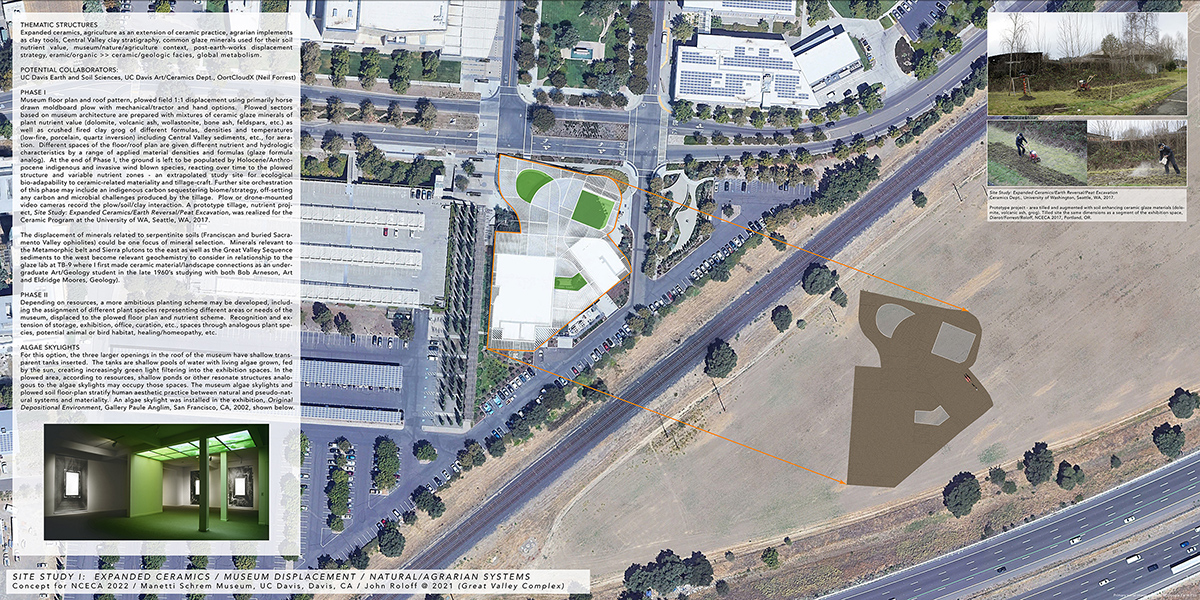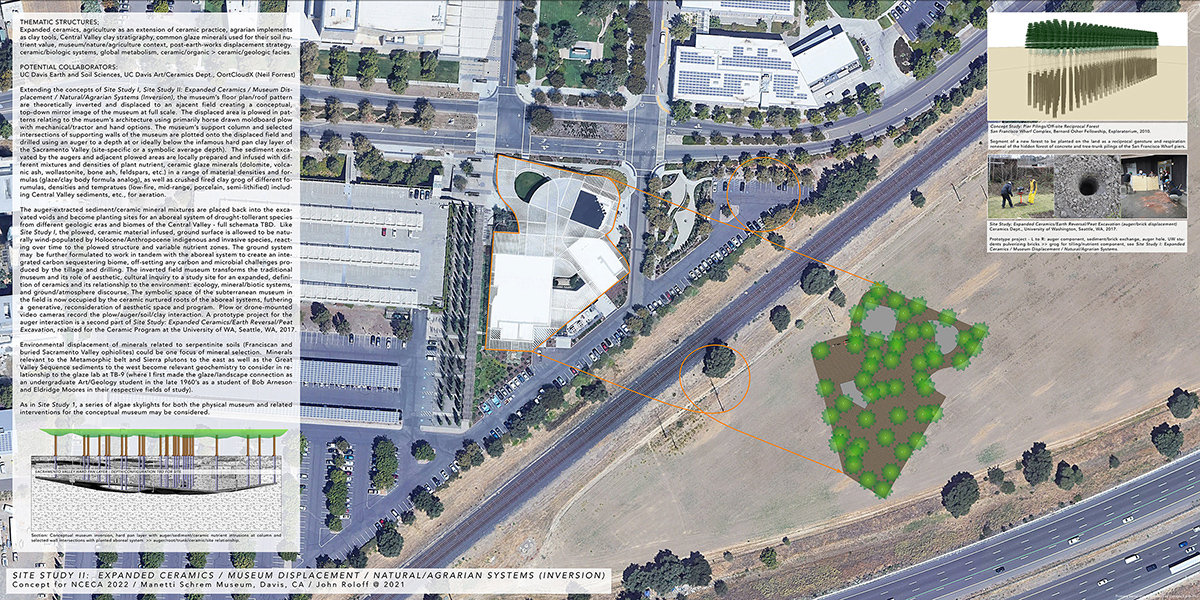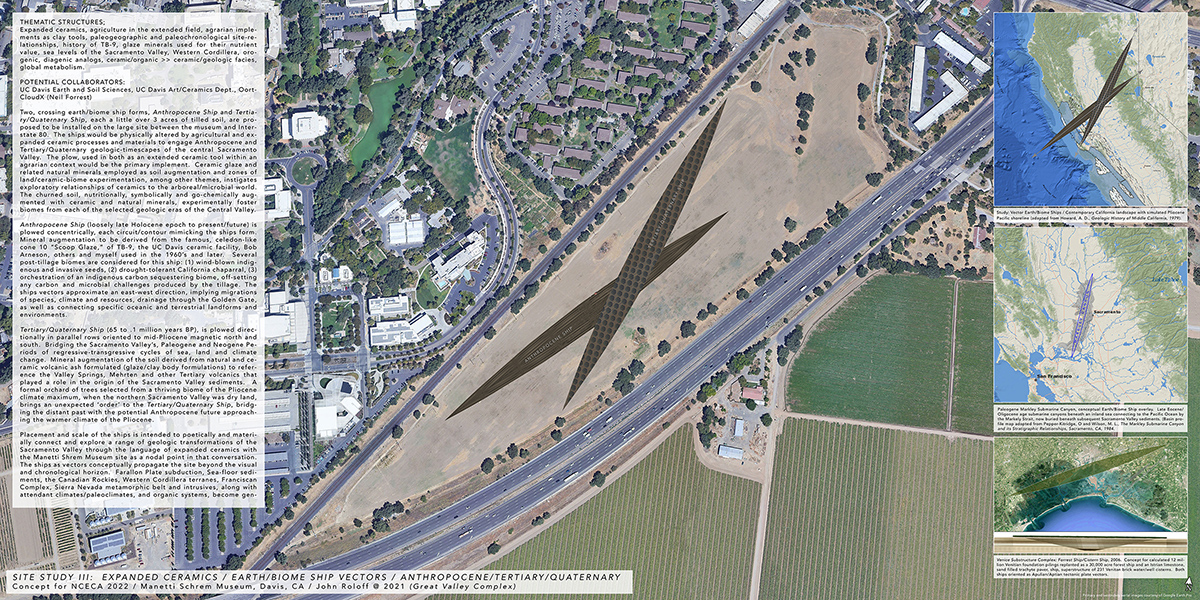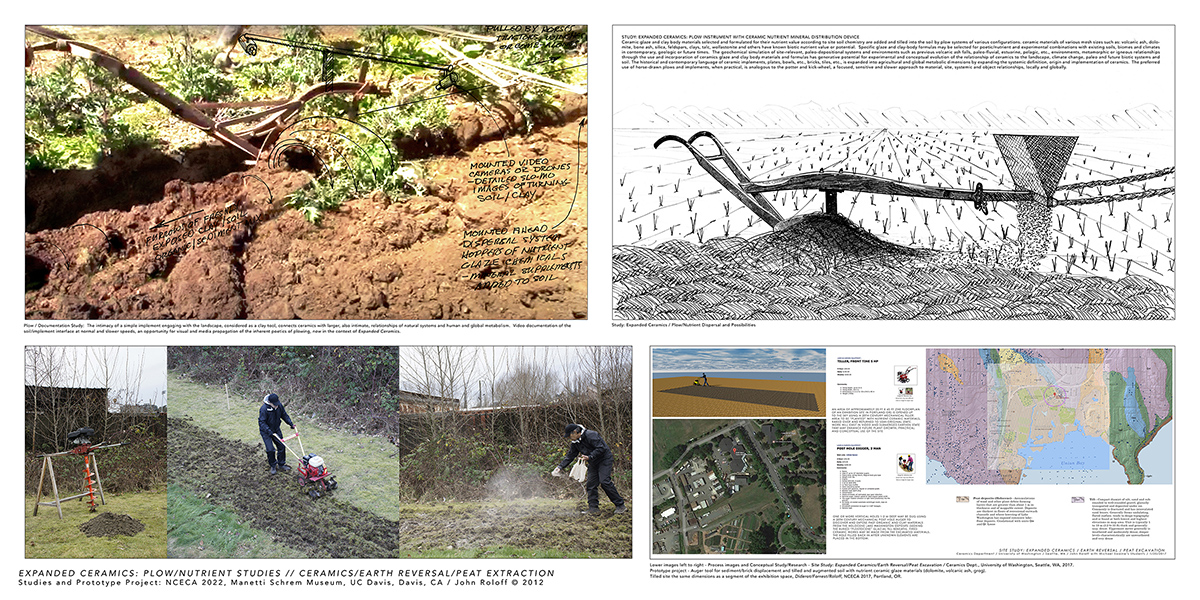A geologic site study revealed two available Quaternary, surficial, strata for physical investigation using a motorized tiller and auger seen as clay tools performing in the context of an expanded definition of ceramics that includes: agriculture, geology and the landscape. Two strata were within reach of the project, the uppermost an approximately 1 meter deep Holocene deposit of Lake Washington peat overlying 1 to 10 meter Pleistocene glacial tills left by receding glaciers. A preliminary video edit of the project and sediment bricks described below were used in the exhibition, Diderot/Forrest/Roloff at NCECA 2017, Portland, OR. Long-term investigations of ceramics as a function of geologic materials and processes as well as inspiration from Diderot’s Encyclopedia were instrumental in the development of this project.
Text for: STUDY: EXPANDED CERAMICS: PLOW INSTRUMENT WITH CERAMIC NUTRIENT MINERAL DISTRIBUTION DEVICE
Ceramic glaze and clay body materials selected and formulated for their nutrient value according to site soil chemistry are added and tilled into the soil by plow systems of various configurations. ceramic materials of various mesh sizes such as: volcanic ash, dolomite, bone ash, silica, feldspars, clays, talc, wollastonite and others have known biotic nutrient value or potential. Specific glaze and clay-body formulas may be selected for poetic/nutrient and experimental combinations with existing soils, biomes and climates in contemporary, geologic or future times. The geochemical simulation of site-relevant, paleo-depositional systems and environments such as previous volcanic ash falls, paleo-fluvial, estuarine, pelagic, etc., environments, metamorphic or igneous relationships through the use and incorporation of ceramics glaze and clay body materials and formulas has generative potential for experimental and conceptual evolution of the relationship of ceramics to the landscape, climate change, paleo and future biotic systems and soil. The historical and contemporary language of ceramic implements, plates, bowls, etc., bricks, tiles, etc., is expanded into agricultural and global metabolic dimensions by expanding the systemic definition, origin and implementation of ceramics. The preferred use of horse-drawn plows and implements, when practical, is analogous to the potter and kick-wheel, a focused, sensitive and slower approach to material, site, systemic and object relationships, locally and globally.
|
Text for: SITE STUDY II: EXPANDED CERAMICS / MUSEUM DISPLACEMENT / NATURAL/AGRARIAN SYSTEMS (INVERSION)
THEMATIC STRUCTURES;
Expanded ceramics, agriculture as an extension of ceramic practice, agrarian implements as clay tools, Central Valley clay stratigraphy, common glaze minerals used for their soil nutrient value, museum/nature/agriculture context, post-earth-works displacement strategy. ceramic/biologic systems, global metabolism, ceramic/organic > ceramic/geologic facies.
POTENTIAL COLLABORATORS:
UC Davis Earth and Soil Sciences, UC Davis Art/Ceramics Dept., OortCloudX (Neil Forrest)
Extending the concepts of Site Study I, Site Study II: Expanded Ceramics / Museum Displacement / Natural/Agrarian Systems (Inversion), the museum’s floor plan/roof pattern are theoretically inverted and displaced to an ajacent field creating a conceptual, top-down mirror image of the museum at full scale. The displaced area is plowed in patterns relating to the museum’s architecture using primarily horse drawn moldboard plow with mechanical/tractor and hand options. The museum’s support column and selected intersections of supporting walls of the museum are plotted onto the displaced field and drilled using an auger to a depth at or ideally below the infamous hard pan clay layer of the Sacramento Valley (site-specific or a symbolic average depth). The sediment excavated by the augers and adjacent plowed areas are locally prepared and infused with different mixtures and densities of plant nutrient, ceramic glaze minerals (dolomite, volcanic ash, wollastonite, bone ash, feldspars, etc.) in a range of material densities and formulas (glaze/clay body formula analog), as well as crushed fired clay grog of different forumulas, densities and tempratues (low-fire, mid-range, porcelain, semi-lithified) including Central Valley sediments, etc., for aeration.
The auger-extracted sediment/ceramic mineral mixtures are placed back into the excavated voids and become planting sites for an aboreal system of drought-tollerant species from different geologic eras and biomes of the Central Valley - full schemata TBD. Like Site Study I, the plowed, ceramic material infused, ground surface is allowed to be naturally wind-populated by Holocene/Anthropocene indigenous and invasive species, reacting over time to the plowed structure and variable nutrient zones. The ground system may be further formulated to work in tandem with the aboreal system to create an integrated carbon sequestering biome, off-setting any carbon and microbial challenges produced by the tillage and drilling. The inverted field museum transforms the traditional museum and its role of aesthetic, cultural inquiry to a study site for an expanded, definition of ceramics and its relationship to the environment: ecology, mineral/biotic systems, and ground/atmosphere discourse. The symbolic space of the subterranean museum in the field is now occupied by the ceramic nurtured roots of the aboreal systems, futhering a generative, reconsideration of aesthetic space and program. Plow or drone-mounted video cameras record the plow/auger/soil/clay interaction. A prototype project for the auger interaction is a second part of Site Study: Expanded Ceramics/Earth Reversal/Peat Excavation, realized for the Ceramic Program at the University of WA, Seattle, WA, 2017.
Environmental displacement of minerals related to serpentinite soils (Franciscan and buried Sacramento Valley ophiolites) could be one focus of mineral selection. Minerals relevant to the Metamorphic belt and Sierra plutons to the east as well as the Great Valley Sequence sediments to the west become relevant geochemistry to consider in relationship to the glaze lab at TB-9 (where I first made the glaze/landscape connection as an undergraduate Art/Geology student in the late 1960’s as a student of Bob Arneson and Eldridge Moores in their respective fields of study).
As in Site Study 1, a series of algae skylights for both the physical museum and related interventions for the conceptual museum may be considered. |







